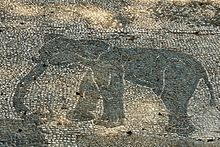North African elephant
 From Wikipedia - Reading time: 7 min
From Wikipedia - Reading time: 7 min
| North African elephant Temporal range: Holocene
| |
|---|---|

| |
| Roman mosaic at Ostia Antica, Italy | |
| Scientific classification | |
| Domain: | Eukaryota |
| Kingdom: | Animalia |
| Phylum: | Chordata |
| Class: | Mammalia |
| Order: | Proboscidea |
| Family: | Elephantidae |
| Genus: | Loxodonta |
| Species: | |
| Subspecies: | †L. a. pharaoensis
|
| Trinomial name | |
| †Loxodonta africana pharaoensis Deraniyagala, 1948
| |
The North African elephant (Loxodonta africana pharaohensis) is an extinct subspecies of the African bush elephant (Loxodonta africana), or possibly a separate elephant species, that existed in North Africa, north of the Sahara, until it died out in Roman times. These were the famous war elephants used by Carthage in the Punic Wars, their conflict with the Roman Republic. Although the subspecies has been formally described,[2][3] it has not been widely recognized by taxonomists. Other names for this animal include the North African forest elephant, Carthaginian elephant, and Atlas elephant. Originally, its natural range probably extended across North Africa and down to the present Sudanese and Eritrean coasts.
Description
[edit]
Carthaginian frescoes[4] and coins minted by whoever controlled North Africa at various times show very small elephants, perhaps 2.5 metres (8 ft 2 in) at the shoulder, with the large ears and concave back typical of modern African elephants. The North African elephant was smaller than the modern African bush elephant (L. a. africana), probably similar in size to the modern African forest elephant (L. cyclotis).
History
[edit]The North African elephant was a significant animal in Nubian culture. They were depicted on the walls of temples and on Meroitic lamps. Kushite kings also utilize war elephants, which are believed to have been kept and trained in the "Great Enclosure" at Musawwarat al-Sufa. The Kingdom of Kush provided these war elephants to the Egyptians, Ptolemies and Syrians.[5]
After they conquered Sicily in 242 BC, the Romans tried to capture some specimens that had been left behind in the middle of the island by the Carthaginians, but failed in the endeavor. The elephants with which Hannibal crossed the Pyrenees and the Alps in order to invade Italy during the Second Punic War (218–201 BC) belonged to this group, with the exception of Hannibal's personal animal, Surus (meaning "the Syrian," or possibly "One-Tusker").[6] This individual, according to his documented name and large size, may have been a Syrian elephant (Elephas maximus asurus), which was possibly a subspecies of the Asian elephant that became extinct shortly after Hannibal invaded Italy, but before the extinction of the North African elephant.[citation needed]
The North African elephant was also used by the Ptolemaic dynasty of Egypt. Writing in the 2nd century BC, Polybius (The Histories; 5.84) described their inferiority in battle against the larger Indian elephants used by the Seleucid kings. A surviving Ptolemaic inscription enumerates three types of war elephant: the "Troglodytic" (probably Libyan), the "Ethiopian", and the "Indian". The Ptolemaic king prides himself on being the first to tame the Ethiopian elephants, a stock which could be identical to one of the two extant African species.[7]
During the reign of Augustus, about 3,500 elephants were killed in Roman circus games,[8][specify] and this prolonged use as a beast in games of baiting along with hunting would drive the species to extinction at the 4th century AD.[9]
Taxonomic uncertainty
[edit]Given the relatively recent date of its disappearance, the status of this population can probably be resolved through ancient DNA sequence analyses, if specimens of definite North African origin can be located and examined. Remains dating to the time of the Roman Republic from Tetouan, Morocco, identified as those of an elephant by collagen fingerprinting, likely belong to this taxon.[10]
See also
[edit]References
[edit]- ^ Pritisk, Yuri (November 2019). "North African or Carthaginian elephant (Loxodonta africana pharaohensis)". Smithsonian magazine. Retrieved 5 January 2023.
- ^ Nowak, Ronald M. (1999). Walker's Mammals of the World (6 ed.). Baltimore: Johns Hopkins University Press. p. 1002. ISBN 978-0-8018-5789-8.
- ^ Yalden, D. W.; Largen, M. J.; Kock, D. (1986). "Catalogue of the Mammals of Ethiopia (III: Order Proboscidea)". Monitore Zoologico Italiano, Supplemento. 21 (1): 46–52. doi:10.1080/03749444.1986.10736707.
- ^ tunisie : Tunisie, Carthage, la ville disparue
- ^ Fisher, Marjorie M.; Lacovara, Peter; Ikram, Salima; D'Auria, Sue; Yellin, Janice W.; Knoblauch, Christian (2012). Ancient Nubia: African Kingdoms on the Nile. Cairo, Egypt: American University in Cairo Press. pp. 216–217. ISBN 9789774164781.
- ^ Scullard, H. H. (1953). "Ennius, Cato, and Surus". The Classical Review. 3 (3/4): 140–142. doi:10.1017/S0009840X00995805. JSTOR 703426. S2CID 162984205.
- ^ "Chronicle concerning the Invasion of Ptolemy III". Livius. BCHP 11, the Ptolemy III Chronicle (Invasion of Ptolemy III Chronicle).
- ^ Greg Woolf (2007). Ancient civilizations: the illustrated guide to belief, mythology, and art. Barnes & Noble. p. 397. ISBN 978-1-4351-0121-0.
- ^ Pritisk, Yuri (November 2019). "North African or Carthaginian elephant (Loxodonta africana pharaohensis)". Smithsonian magazine. Retrieved 5 January 2023.
- ^ Rodrigues, Ana S. L.; Charpentier, Anne; Bernal-Casasola, Darío; Gardeisen, Armelle; Nores, Carlos; Pis Millán, José Antonio; McGrath, Krista; Speller, Camilla F. (2018-07-11). "Forgotten Mediterranean calving grounds of grey and North Atlantic right whales: evidence from Roman archaeological records". Proceedings of the Royal Society B: Biological Sciences. 285 (1882): 20180961. doi:10.1098/rspb.2018.0961. ISSN 0962-8452. PMC 6053924. PMID 30051821.
 KSF
KSF